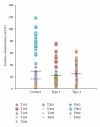Analysis of insulin in human breast milk in mothers with type 1 and type 2 diabetes mellitus
- PMID: 22500167
- PMCID: PMC3303574
- DOI: 10.1155/2012/296368
Analysis of insulin in human breast milk in mothers with type 1 and type 2 diabetes mellitus
Abstract
Despite the important role that insulin plays in the human body, very little is known about its presence in human milk. Levels rapidly decrease during the first few days of lactation and then, unlike other serum proteins of similar size, achieve comparable levels to those in serum. Despite this, current guides for medical treatment suggest that insulin does not pass into milk, raising the question of where the insulin in milk originates. Five mothers without diabetes, 4 mothers with type 1, and 5 mothers with type 2 diabetes collected milk samples over a 24-hour period. Samples were analysed for total and endogenous insulin content and for c-peptide content. All of the insulin present in the milk of type 1 mothers was artificial, and c-peptide levels were 100x lower than in serum. This demonstrates that insulin is transported into human milk at comparable concentration to serum, suggesting an active transport mechanism. The role of insulin in milk is yet to be determined; however, there are a number of potential implications for the infant of the presence of artificial insulins in milk.
Figures




References
-
- Koldovský O. Hormones in Milk. Vitamins & Hormones. 1995;50:77–149. - PubMed
-
- Kulski JK, Hartmann PE. Milk insulin, GH and TSH: relationship to changes in milk lactose, glucose and protein during lactogenesis in women. Endocrinologia Experimentalis. 1983;17(3-4):317–326. - PubMed
-
- Tiittanen M, Paronen J, Savilahti E, et al. Dietary insulin as an immunogen and tolerogen. Pediatric Allergy and Immunology. 2006;17(7):538–543. - PubMed
-
- Briggs GG, Freeman RK, Yaffe SJ. Drugs in Pregnancy and Lactation: A Reference Guide to Fetal and Neonatal Risk. 7th edition. Philadelphia, Pa, USA: Lippincott Williams & Wilkins; 2005.
LinkOut - more resources
Full Text Sources
Other Literature Sources

